Yahong Han
Visual Consensus Prompting for Co-Salient Object Detection
Apr 19, 2025Abstract:Existing co-salient object detection (CoSOD) methods generally employ a three-stage architecture (i.e., encoding, consensus extraction & dispersion, and prediction) along with a typical full fine-tuning paradigm. Although they yield certain benefits, they exhibit two notable limitations: 1) This architecture relies on encoded features to facilitate consensus extraction, but the meticulously extracted consensus does not provide timely guidance to the encoding stage. 2) This paradigm involves globally updating all parameters of the model, which is parameter-inefficient and hinders the effective representation of knowledge within the foundation model for this task. Therefore, in this paper, we propose an interaction-effective and parameter-efficient concise architecture for the CoSOD task, addressing two key limitations. It introduces, for the first time, a parameter-efficient prompt tuning paradigm and seamlessly embeds consensus into the prompts to formulate task-specific Visual Consensus Prompts (VCP). Our VCP aims to induce the frozen foundation model to perform better on CoSOD tasks by formulating task-specific visual consensus prompts with minimized tunable parameters. Concretely, the primary insight of the purposeful Consensus Prompt Generator (CPG) is to enforce limited tunable parameters to focus on co-salient representations and generate consensus prompts. The formulated Consensus Prompt Disperser (CPD) leverages consensus prompts to form task-specific visual consensus prompts, thereby arousing the powerful potential of pre-trained models in addressing CoSOD tasks. Extensive experiments demonstrate that our concise VCP outperforms 13 cutting-edge full fine-tuning models, achieving the new state of the art (with 6.8% improvement in F_m metrics on the most challenging CoCA dataset). Source code has been available at https://github.com/WJ-CV/VCP.
Style Evolving along Chain-of-Thought for Unknown-Domain Object Detection
Mar 13, 2025Abstract:Recently, a task of Single-Domain Generalized Object Detection (Single-DGOD) is proposed, aiming to generalize a detector to multiple unknown domains never seen before during training. Due to the unavailability of target-domain data, some methods leverage the multimodal capabilities of vision-language models, using textual prompts to estimate cross-domain information, enhancing the model's generalization capability. These methods typically use a single textual prompt, often referred to as the one-step prompt method. However, when dealing with complex styles such as the combination of rain and night, we observe that the performance of the one-step prompt method tends to be relatively weak. The reason may be that many scenes incorporate not just a single style but a combination of multiple styles. The one-step prompt method may not effectively synthesize combined information involving various styles. To address this limitation, we propose a new method, i.e., Style Evolving along Chain-of-Thought, which aims to progressively integrate and expand style information along the chain of thought, enabling the continual evolution of styles. Specifically, by progressively refining style descriptions and guiding the diverse evolution of styles, this approach enables more accurate simulation of various style characteristics and helps the model gradually learn and adapt to subtle differences between styles. Additionally, it exposes the model to a broader range of style features with different data distributions, thereby enhancing its generalization capability in unseen domains. The significant performance gains over five adverse-weather scenarios and the Real to Art benchmark demonstrate the superiorities of our method.
Behavior-Contextualized Item Preference Modeling for Multi-Behavior Recommendation
Apr 28, 2024Abstract:In recommender systems, multi-behavior methods have demonstrated their effectiveness in mitigating issues like data sparsity, a common challenge in traditional single-behavior recommendation approaches. These methods typically infer user preferences from various auxiliary behaviors and apply them to the target behavior for recommendations. However, this direct transfer can introduce noise to the target behavior in recommendation, due to variations in user attention across different behaviors. To address this issue, this paper introduces a novel approach, Behavior-Contextualized Item Preference Modeling (BCIPM), for multi-behavior recommendation. Our proposed Behavior-Contextualized Item Preference Network discerns and learns users' specific item preferences within each behavior. It then considers only those preferences relevant to the target behavior for final recommendations, significantly reducing noise from auxiliary behaviors. These auxiliary behaviors are utilized solely for training the network parameters, thereby refining the learning process without compromising the accuracy of the target behavior recommendations. To further enhance the effectiveness of BCIPM, we adopt a strategy of pre-training the initial embeddings. This step is crucial for enriching the item-aware preferences, particularly in scenarios where data related to the target behavior is sparse. Comprehensive experiments conducted on four real-world datasets demonstrate BCIPM's superior performance compared to several leading state-of-the-art models, validating the robustness and efficiency of our proposed approach.
Generalizing to Out-of-Sample Degradations via Model Reprogramming
Mar 09, 2024



Abstract:Existing image restoration models are typically designed for specific tasks and struggle to generalize to out-of-sample degradations not encountered during training. While zero-shot methods can address this limitation by fine-tuning model parameters on testing samples, their effectiveness relies on predefined natural priors and physical models of specific degradations. Nevertheless, determining out-of-sample degradations faced in real-world scenarios is always impractical. As a result, it is more desirable to train restoration models with inherent generalization ability. To this end, this work introduces the Out-of-Sample Restoration (OSR) task, which aims to develop restoration models capable of handling out-of-sample degradations. An intuitive solution involves pre-translating out-of-sample degradations to known degradations of restoration models. However, directly translating them in the image space could lead to complex image translation issues. To address this issue, we propose a model reprogramming framework, which translates out-of-sample degradations by quantum mechanic and wave functions. Specifically, input images are decoupled as wave functions of amplitude and phase terms. The translation of out-of-sample degradation is performed by adapting the phase term. Meanwhile, the image content is maintained and enhanced in the amplitude term. By taking these two terms as inputs, restoration models are able to handle out-of-sample degradations without fine-tuning. Through extensive experiments across multiple evaluation cases, we demonstrate the effectiveness and flexibility of our proposed framework. Our codes are available at \href{https://github.com/ddghjikle/Out-of-sample-restoration}{Github}.
Prompt-Driven Dynamic Object-Centric Learning for Single Domain Generalization
Feb 28, 2024Abstract:Single-domain generalization aims to learn a model from single source domain data to achieve generalized performance on other unseen target domains. Existing works primarily focus on improving the generalization ability of static networks. However, static networks are unable to dynamically adapt to the diverse variations in different image scenes, leading to limited generalization capability. Different scenes exhibit varying levels of complexity, and the complexity of images further varies significantly in cross-domain scenarios. In this paper, we propose a dynamic object-centric perception network based on prompt learning, aiming to adapt to the variations in image complexity. Specifically, we propose an object-centric gating module based on prompt learning to focus attention on the object-centric features guided by the various scene prompts. Then, with the object-centric gating masks, the dynamic selective module dynamically selects highly correlated feature regions in both spatial and channel dimensions enabling the model to adaptively perceive object-centric relevant features, thereby enhancing the generalization capability. Extensive experiments were conducted on single-domain generalization tasks in image classification and object detection. The experimental results demonstrate that our approach outperforms state-of-the-art methods, which validates the effectiveness and generally of our proposed method.
Weakly-Supervised Video Anomaly Detection with Snippet Anomalous Attention
Sep 28, 2023



Abstract:With a focus on abnormal events contained within untrimmed videos, there is increasing interest among researchers in video anomaly detection. Among different video anomaly detection scenarios, weakly-supervised video anomaly detection poses a significant challenge as it lacks frame-wise labels during the training stage, only relying on video-level labels as coarse supervision. Previous methods have made attempts to either learn discriminative features in an end-to-end manner or employ a twostage self-training strategy to generate snippet-level pseudo labels. However, both approaches have certain limitations. The former tends to overlook informative features at the snippet level, while the latter can be susceptible to noises. In this paper, we propose an Anomalous Attention mechanism for weakly-supervised anomaly detection to tackle the aforementioned problems. Our approach takes into account snippet-level encoded features without the supervision of pseudo labels. Specifically, our approach first generates snippet-level anomalous attention and then feeds it together with original anomaly scores into a Multi-branch Supervision Module. The module learns different areas of the video, including areas that are challenging to detect, and also assists the attention optimization. Experiments on benchmark datasets XDViolence and UCF-Crime verify the effectiveness of our method. Besides, thanks to the proposed snippet-level attention, we obtain a more precise anomaly localization.
Joint Correcting and Refinement for Balanced Low-Light Image Enhancement
Sep 28, 2023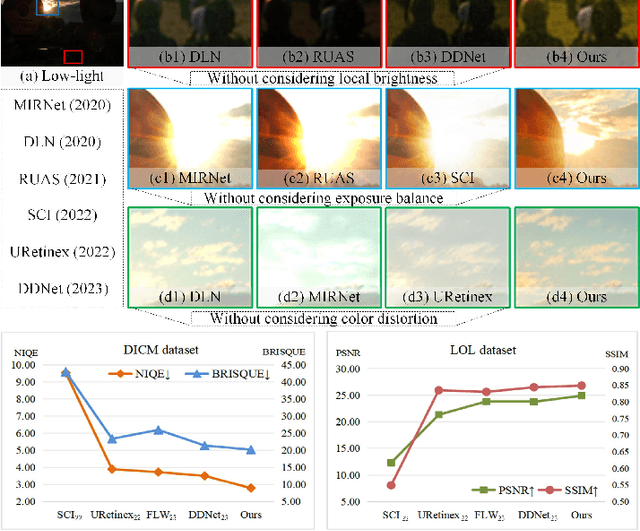



Abstract:Low-light image enhancement tasks demand an appropriate balance among brightness, color, and illumination. While existing methods often focus on one aspect of the image without considering how to pay attention to this balance, which will cause problems of color distortion and overexposure etc. This seriously affects both human visual perception and the performance of high-level visual models. In this work, a novel synergistic structure is proposed which can balance brightness, color, and illumination more effectively. Specifically, the proposed method, so-called Joint Correcting and Refinement Network (JCRNet), which mainly consists of three stages to balance brightness, color, and illumination of enhancement. Stage 1: we utilize a basic encoder-decoder and local supervision mechanism to extract local information and more comprehensive details for enhancement. Stage 2: cross-stage feature transmission and spatial feature transformation further facilitate color correction and feature refinement. Stage 3: we employ a dynamic illumination adjustment approach to embed residuals between predicted and ground truth images into the model, adaptively adjusting illumination balance. Extensive experiments demonstrate that the proposed method exhibits comprehensive performance advantages over 21 state-of-the-art methods on 9 benchmark datasets. Furthermore, a more persuasive experiment has been conducted to validate our approach the effectiveness in downstream visual tasks (e.g., saliency detection). Compared to several enhancement models, the proposed method effectively improves the segmentation results and quantitative metrics of saliency detection. The source code will be available at https://github.com/woshiyll/JCRNet.
Prototype-guided Cross-task Knowledge Distillation for Large-scale Models
Dec 26, 2022



Abstract:Recently, large-scale pre-trained models have shown their advantages in many tasks. However, due to the huge computational complexity and storage requirements, it is challenging to apply the large-scale model to real scenes. A common solution is knowledge distillation which regards the large-scale model as a teacher model and helps to train a small student model to obtain a competitive performance. Cross-task Knowledge distillation expands the application scenarios of the large-scale pre-trained model. Existing knowledge distillation works focus on directly mimicking the final prediction or the intermediate layers of the teacher model, which represent the global-level characteristics and are task-specific. To alleviate the constraint of different label spaces, capturing invariant intrinsic local object characteristics (such as the shape characteristics of the leg and tail of the cattle and horse) plays a key role. Considering the complexity and variability of real scene tasks, we propose a Prototype-guided Cross-task Knowledge Distillation (ProC-KD) approach to transfer the intrinsic local-level object knowledge of a large-scale teacher network to various task scenarios. First, to better transfer the generalized knowledge in the teacher model in cross-task scenarios, we propose a prototype learning module to learn from the essential feature representation of objects in the teacher model. Secondly, for diverse downstream tasks, we propose a task-adaptive feature augmentation module to enhance the features of the student model with the learned generalization prototype features and guide the training of the student model to improve its generalization ability. The experimental results on various visual tasks demonstrate the effectiveness of our approach for large-scale model cross-task knowledge distillation scenes.
Peng Cheng Object Detection Benchmark for Smart City
Mar 11, 2022

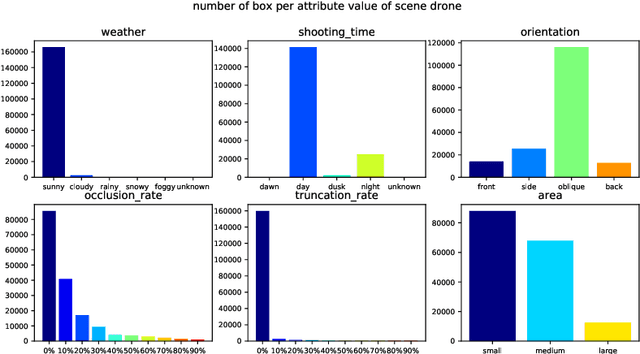
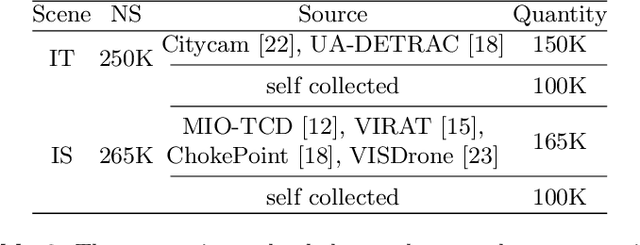
Abstract:Object detection is an algorithm that recognizes and locates the objects in the image and has a wide range of applications in the visual understanding of complex urban scenes. Existing object detection benchmarks mainly focus on a single specific scenario and their annotation attributes are not rich enough, these make the object detection model is not generalized for the smart city scenes. Considering the diversity and complexity of scenes in intelligent city governance, we build a large-scale object detection benchmark for the smart city. Our benchmark contains about 500K images and includes three scenarios: intelligent transportation, intelligent security, and drones. For the complexity of the real scene in the smart city, the diversity of weather, occlusion, and other complex environment diversity attributes of the images in the three scenes are annotated. The characteristics of the benchmark are analyzed and extensive experiments of the current state-of-the-art target detection algorithm are conducted based on our benchmark to show their performance.
Action Keypoint Network for Efficient Video Recognition
Jan 17, 2022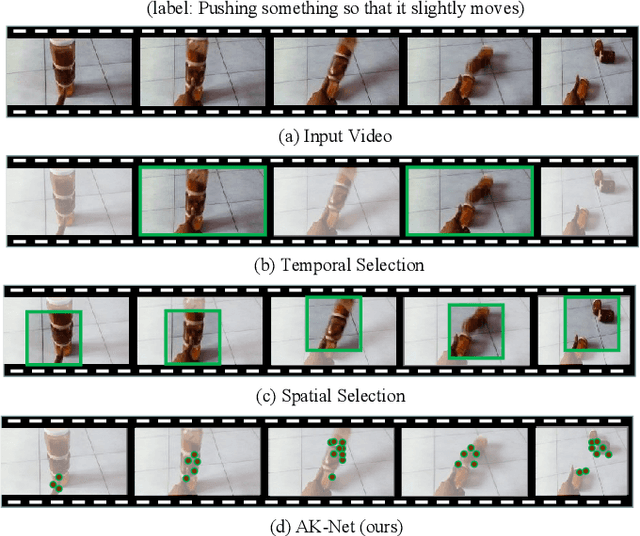
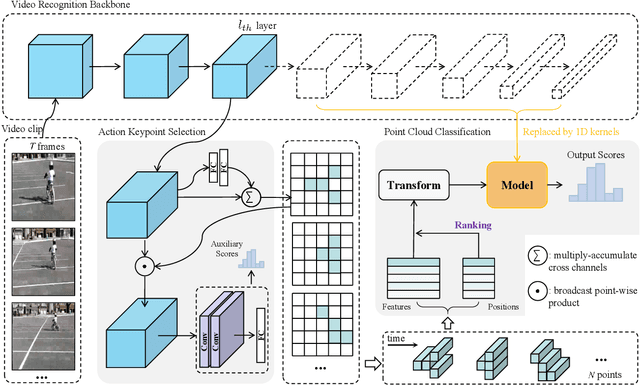
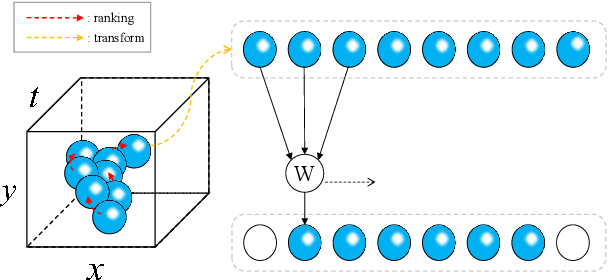
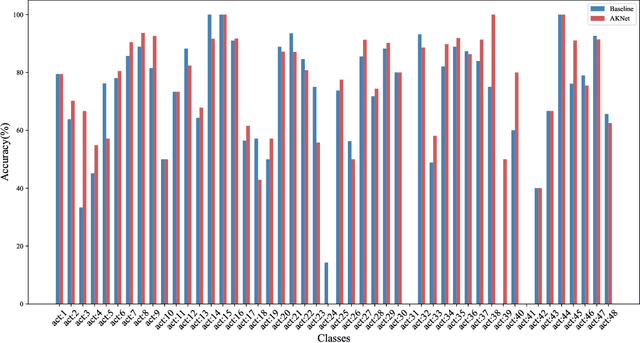
Abstract:Reducing redundancy is crucial for improving the efficiency of video recognition models. An effective approach is to select informative content from the holistic video, yielding a popular family of dynamic video recognition methods. However, existing dynamic methods focus on either temporal or spatial selection independently while neglecting a reality that the redundancies are usually spatial and temporal, simultaneously. Moreover, their selected content is usually cropped with fixed shapes, while the realistic distribution of informative content can be much more diverse. With these two insights, this paper proposes to integrate temporal and spatial selection into an Action Keypoint Network (AK-Net). From different frames and positions, AK-Net selects some informative points scattered in arbitrary-shaped regions as a set of action keypoints and then transforms the video recognition into point cloud classification. AK-Net has two steps, i.e., the keypoint selection and the point cloud classification. First, it inputs the video into a baseline network and outputs a feature map from an intermediate layer. We view each pixel on this feature map as a spatial-temporal point and select some informative keypoints using self-attention. Second, AK-Net devises a ranking criterion to arrange the keypoints into an ordered 1D sequence. Consequentially, AK-Net brings two-fold benefits for efficiency: The keypoint selection step collects informative content within arbitrary shapes and increases the efficiency for modeling spatial-temporal dependencies, while the point cloud classification step further reduces the computational cost by compacting the convolutional kernels. Experimental results show that AK-Net can consistently improve the efficiency and performance of baseline methods on several video recognition benchmarks.
 Add to Chrome
Add to Chrome Add to Firefox
Add to Firefox Add to Edge
Add to Edge